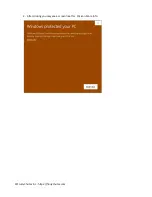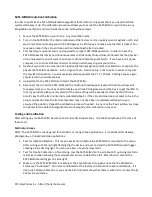
4. With the drone level on the ground using the ShootyChute UI check that the virtual drone should also
be level.
5. Rotating the drone will cause the virtual drone to rotate.
6. Test the parachute channel endpoints. You can toggle the SATS-MINI states using the mode pulldown.
If you have an energetic parachute system like CO2 or Pyro be sure to disconnect these first. Use a
servo to test for channel operation.
7. If you are using advanced features like altimeter safety or overrides be sure to verify these in a barro
chamber (Jar with a tube you can suck on to cause a vacuum).
8. If you are using external trigger input be sure to test again for proper operation.
9. Dry run your setup - If you are concerned about possible false triggers due to sensitive setup
parameters test fly the SATS-MINI on your drone first and make sure the device does not trigger
accidentally. Fly the drone at the edges of the flight envelope to see if you can false trigger the SATS. If
you do see a false trigger then download the flight log to see the conditions. You may need to adjust
the trigger settings.
10. After testing, download the Log file and verify for expected operation.
Fixed Wing using Absolute Angle
Testing is similar to Multirotor Drones except we are testing Absolute Angle detection features.
NOTE: The SATS-MINI is not designed for Fixed Wing aerobatic applications. It is optimized for delivery,
photography, or industrial drone applications.
1. Test Pitch and Roll settings by rotating the SATS-MINI to the trigger angle or slightly beyond. Moving
quickly well past the trigger angle will result in a faster trigger. Also using shorter times for averaging
will also speed up the detection, but it will be less immune to larger rotation for short times. Be sure to
ground test all angle parameters.
2. Test Angle rate of change. Rotating the SATS faster, even for a short time, will cause a large angular
rate of change.
3. For Fixed Angle it's a very good idea to flight test using your FixedWing drone. Fly the drone up to the
expected flight envelope you expect. Then analyze the log files to see if you have any false triggers that
are not expected. If so adjust those parameters and fly again.
Tips for Flight Testing
You can use your Multicopter or Fixed Wing drone and test flying to quickly understand what the flight
envelope is. After flying the Log file will record all the rotations, accelerations, and angular rotation rates.
For Multicopters set the rotation angles to be very large and time short so it’s very hard to false trigger. For
Absolute Angle set the angle settings to 0 to disable these. Then go through some tests flying the drone how
you would expect in actual use. Then download the log. In Excel you can measure the MAX and MIN limits for
the columns to quickly understand what the limits are. To do this use in Excel the formula MAX(range), or
MIN(range) on each of the columns to understand the limits. Then tune your SATS-MINI setting for these
maximums and minimums plus extra margin so you have some safety margin against false deployment.
Continue to test fly to gain confidence it will not false trigger.
Likewise it’s important to fly the drones at extremes outside the envelope to make sure the SATS-MINI does
catch these. These can also include forward stalls, tip stalls, or flat spins.
© Fruity Chutes Inc - https://fruitychutes.com


































